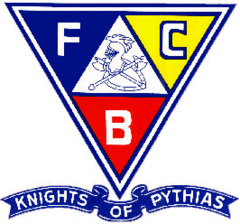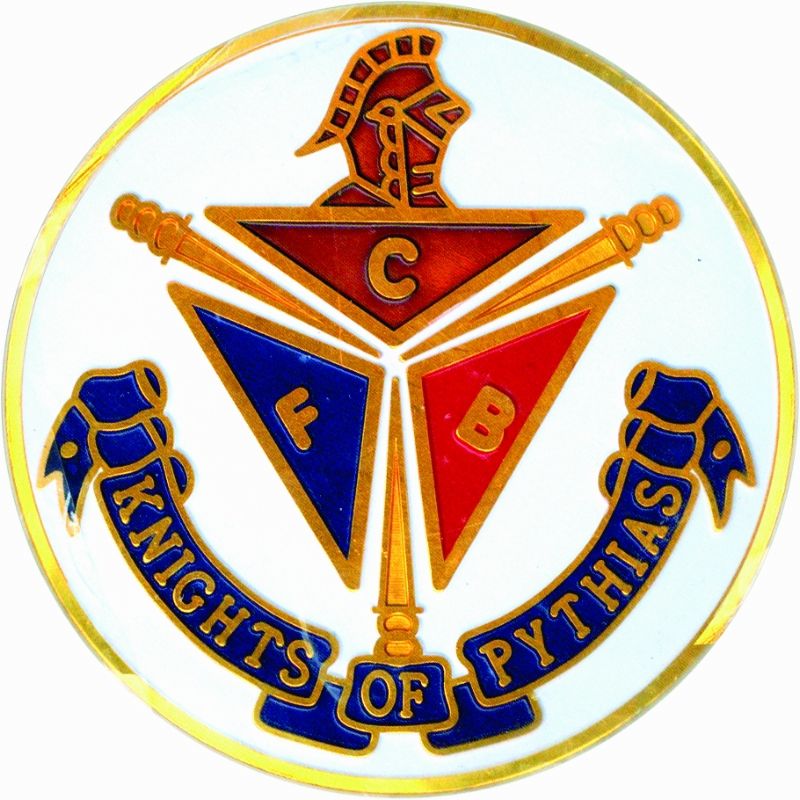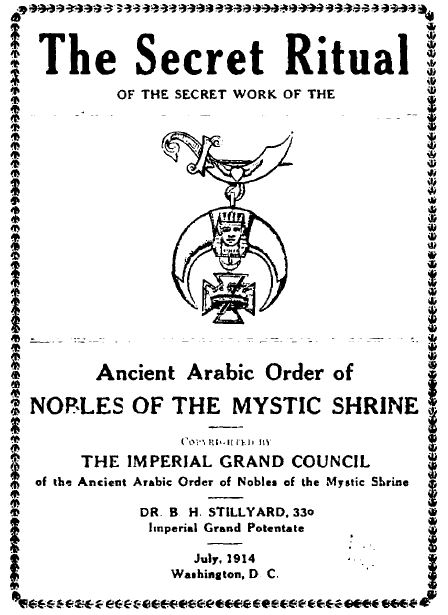The Knights of Pythias is a fraternal organization and secret society founded at Washington, DC, on 19 February 1864.
 The Knights of Pythias was the first fraternl organization to receive a charter under an act of the United States Congress. It was founded by Justus H. Rathbone, who had been inspired by a play by the Irish poet John Banim about the legend of Damon and Pythias. This legend illustrates the ideals of loyalty, honor and friendship that are central to the order.
The Knights of Pythias was the first fraternl organization to receive a charter under an act of the United States Congress. It was founded by Justus H. Rathbone, who had been inspired by a play by the Irish poet John Banim about the legend of Damon and Pythias. This legend illustrates the ideals of loyalty, honor and friendship that are central to the order.
The order has over two thousand lodges in the United States and around the world, with a total membership of over 50,000 in 2003. Some lodges meet in structures referred to as Pythian Castles.
As the fraternal boom of the late 19th Century took hold, many organizations sprouted up, mostly to provide insurance to members, while others were really trying to provide a fraternal experience. The top two in the later category were the Freemasons and the Odd Fellows. The number three dog, however, was the Knights of Pythias. The organization had many internal issues and fractures, as well as several appendant bodies. But, like most fraternal groups, the basic Lodge was the most powerful. On a national level, the Grand Lodge of Pennsylvania controlled the most sway.
Pythian Lodge Fez
 As this fez was aquired in Pennsylvania, it is anticipated that this is where Portage Lodge No. 138 would have been from. The fez is poor condition, thanks to a small stain and a fraying top knot, but, due to its rarity, it fills an important role in the collection.
As this fez was aquired in Pennsylvania, it is anticipated that this is where Portage Lodge No. 138 would have been from. The fez is poor condition, thanks to a small stain and a fraying top knot, but, due to its rarity, it fills an important role in the collection.
One of the great things about fez collecting is the variety of pieces you find. Compared to our first Knights of Pythias fez, this one is quite different. While the emblem remains somewhat similar to the example above, here we have a fez in a completely different color (deep blue) and a different tassel. Based on some research, Comet Lodge No. 60 is located in Ohio and is still active. Using the design and manufacturing details of this piece, we place to to be from the 30’s (or earlier.)
 We continue to discover new variations on fezzes worn by the Knights of Pythias. This fez, purchased at auction, isn’t immediately recognizable as a Knights of Pythias piece, as it lacks the tradition “FCB” that you see on the logo. However, the inverse triangle, sporting the colors yellow, blue, and red are a dead giveaway to someone who knows what they are looking at. This piece is purple, with the emblem being embroidered. In the center of the emblem is an open book. This symbol is most typically used by fraternal groups to designate a Chaplain, so we presume that this is a Chaplain’s fez. The felt is purple and the tassel is a silvery gray. Our best guess on dating this piece is that it is from the 1960’s or ’70’s.
We continue to discover new variations on fezzes worn by the Knights of Pythias. This fez, purchased at auction, isn’t immediately recognizable as a Knights of Pythias piece, as it lacks the tradition “FCB” that you see on the logo. However, the inverse triangle, sporting the colors yellow, blue, and red are a dead giveaway to someone who knows what they are looking at. This piece is purple, with the emblem being embroidered. In the center of the emblem is an open book. This symbol is most typically used by fraternal groups to designate a Chaplain, so we presume that this is a Chaplain’s fez. The felt is purple and the tassel is a silvery gray. Our best guess on dating this piece is that it is from the 1960’s or ’70’s.Dramatic Order Knights of Khorassan Fez
 Pythians are eligible for membership in the Dramatic Order Knights of Khorassan (DOKK). DOKK meetings, ceremonial, customs, and plans are very different from the traditional Lodge functions. Initiates receive, witness, and possibly even become an active participant in the renowned DOKK “Eighth Order”. The DOKK ritual teaches valuable lessons of life and includes a scene which exemplifies their motto “Lift Up The Fallen.” It is rated as one of the finest ritualistic parts ever written for a fraternal body.
Pythians are eligible for membership in the Dramatic Order Knights of Khorassan (DOKK). DOKK meetings, ceremonial, customs, and plans are very different from the traditional Lodge functions. Initiates receive, witness, and possibly even become an active participant in the renowned DOKK “Eighth Order”. The DOKK ritual teaches valuable lessons of life and includes a scene which exemplifies their motto “Lift Up The Fallen.” It is rated as one of the finest ritualistic parts ever written for a fraternal body.Local organizations are known as Temples and were established in communities throughout the United States and Canada. The DOKK is governed by a national organization known as the Imperial Palace. The Imperial Palace is comprised of representatives from Temples across the United States and Canada who meet in convention every two years. The group still exists, albeit with diminished numbers.
This fez can be tracked to New Jersey, where Hegira Temple No. 161 was located. Interestingly, the DOKK is probably one of the most helpful of organizations to collectors, as each “official fez” bears the signature of the Imperial Secretary at the time of its creation. In this case, the fez has the signature of Joseph Elliot, Jr. From what records we have found, Mr. Elliot was Imperial Secretary beginning in September of 1960. He remained in that office until at leas the turn of the decade. That places this fez squarely in the era of the 1960’s. The fez displayed here is a basic members fez, who are termed “Votary.” Regular members wear a black tassel.
 Coming from the same era as our other DOKK piece, this fez shows a marked difference in design and construction. You can see how the letting and design has been done mostly in rhinestones, with little other embroidery. Lastly, in a truly unusual change, the tiger on the fez is completely three dimensional and is sewn on. It has two green jewels for th esyes and a red one in the mouth. The yellow tassel denotes the owner reached the rank of Royal Prince, which is obtained by being a Past Royal Vizier (local President.) Based upon the available information, this fez comes from El Hama Temple No. 257, located in Meridian, Mississippi, which is believed to have been active at least until the late 70’s.
Coming from the same era as our other DOKK piece, this fez shows a marked difference in design and construction. You can see how the letting and design has been done mostly in rhinestones, with little other embroidery. Lastly, in a truly unusual change, the tiger on the fez is completely three dimensional and is sewn on. It has two green jewels for th esyes and a red one in the mouth. The yellow tassel denotes the owner reached the rank of Royal Prince, which is obtained by being a Past Royal Vizier (local President.) Based upon the available information, this fez comes from El Hama Temple No. 257, located in Meridian, Mississippi, which is believed to have been active at least until the late 70’s. Coming from the same era as our other DOKK piece, this fez shows a marked difference in design and construction. You can see how the letting and design has been done mostly in rhinestones, with little other embroidery. Lastly, in a truly unusual change, the tiger on the fez is completely three dimensional and is sewn on. It has two green jewels for th esyes and a red one in the mouth. The yellow tassel denotes the owner reached the rank of Royal Prince, which is obtained by being a Past Royal Vizier (local President.) Based upon the available information, this fez comes from El Hama Temple No. 257, located in Meridian, Mississippi, which is believed to have been active at least until the late 70’s.
Coming from the same era as our other DOKK piece, this fez shows a marked difference in design and construction. You can see how the letting and design has been done mostly in rhinestones, with little other embroidery. Lastly, in a truly unusual change, the tiger on the fez is completely three dimensional and is sewn on. It has two green jewels for th esyes and a red one in the mouth. The yellow tassel denotes the owner reached the rank of Royal Prince, which is obtained by being a Past Royal Vizier (local President.) Based upon the available information, this fez comes from El Hama Temple No. 257, located in Meridian, Mississippi, which is believed to have been active at least until the late 70’s. Filling in yet another minor niche in the collection, the fez above provides a good example of an early DOKK fez completed entirely in bullion. The whole design is worked in gold metallic thread, including the tiger on the front. The tiger is especially nice, as it’s built up, creating a 3d effect. The tassel is yellow, indicating the owner was an officer at some point. Unlike all of the other DOKK fezzes in the collection, this one does not have the signature of the reigning Imperial Secretary inside, making dating the piece difficult. Based on our research, Astrabad Temple No. 151 was located in Manchester, New Hampshire, but is long since closed.
Filling in yet another minor niche in the collection, the fez above provides a good example of an early DOKK fez completed entirely in bullion. The whole design is worked in gold metallic thread, including the tiger on the front. The tiger is especially nice, as it’s built up, creating a 3d effect. The tassel is yellow, indicating the owner was an officer at some point. Unlike all of the other DOKK fezzes in the collection, this one does not have the signature of the reigning Imperial Secretary inside, making dating the piece difficult. Based on our research, Astrabad Temple No. 151 was located in Manchester, New Hampshire, but is long since closed. Here we have another fez from Astrabad Temple No. 151. On first look, this fez is fairly plain, but quite old. It has the shorter tassel style favored prior to the 1960’s and is embroidered in basic thread, instead of bullion. It has no pins or ornamentation, but does have the yellow tassel, indicating the rank of Royal Prince. The reason for this fez being added to the collection lies with the title bar, which reads “D.D. Imperial Prince.” Such a title denotes that the owner was a regional officer for the organization, overseeing several local Temples and reporting on their activities to the national body. The owner, therefore, was a fairly high ranking officer who must have spent much time and energy traveling to the Temples under his purview.
Here we have another fez from Astrabad Temple No. 151. On first look, this fez is fairly plain, but quite old. It has the shorter tassel style favored prior to the 1960’s and is embroidered in basic thread, instead of bullion. It has no pins or ornamentation, but does have the yellow tassel, indicating the rank of Royal Prince. The reason for this fez being added to the collection lies with the title bar, which reads “D.D. Imperial Prince.” Such a title denotes that the owner was a regional officer for the organization, overseeing several local Temples and reporting on their activities to the national body. The owner, therefore, was a fairly high ranking officer who must have spent much time and energy traveling to the Temples under his purview. Hailing from Kashan Temple No. 158, traced to South Bend, Indiana, his fez was added to the collection after purchase from a private seller. It’s an interesting piece, in that the owner has adorned with dozens of pins and patches, almost leaving no room for the tassel. Due to this, the tassel was run down the back of the fez rather than at the side like in most organizations. It is shown at the side here strictly for demonstrative purposes. The tassel is unique, being colored purple and yellow, indicating the owner was a ranking member of the national organization. As the hat would indicate, he would have been the Herald Editor (for the national newsletter) – a pretty high level job in the day.
Hailing from Kashan Temple No. 158, traced to South Bend, Indiana, his fez was added to the collection after purchase from a private seller. It’s an interesting piece, in that the owner has adorned with dozens of pins and patches, almost leaving no room for the tassel. Due to this, the tassel was run down the back of the fez rather than at the side like in most organizations. It is shown at the side here strictly for demonstrative purposes. The tassel is unique, being colored purple and yellow, indicating the owner was a ranking member of the national organization. As the hat would indicate, he would have been the Herald Editor (for the national newsletter) – a pretty high level job in the day. This fez has special meaning to the museum, as it belongs to the curator. During the summer of 2017, our curator joined the Knights of Pythias in Mountain Lodge No. 27, Frederick, MD. Later that same day, he was made a Votary (member) of Ben Hadad Temple No. 93, which covers the State of Maryland.
This fez has special meaning to the museum, as it belongs to the curator. During the summer of 2017, our curator joined the Knights of Pythias in Mountain Lodge No. 27, Frederick, MD. Later that same day, he was made a Votary (member) of Ben Hadad Temple No. 93, which covers the State of Maryland. Fezzes with titles will always entice our collecting proclivities. This fez belonged to an Imperial Secretary of the DOKK. The owner would have overseen the day-to-day operations of the entire organization. There have only been a little over a dozen Imperial Secretaries in the complete history of the DOKK. The current Imperial Secretary is Ken Moder, known for his work with the J.H. Rathbone Museum and Resource Center.
Fezzes with titles will always entice our collecting proclivities. This fez belonged to an Imperial Secretary of the DOKK. The owner would have overseen the day-to-day operations of the entire organization. There have only been a little over a dozen Imperial Secretaries in the complete history of the DOKK. The current Imperial Secretary is Ken Moder, known for his work with the J.H. Rathbone Museum and Resource Center. In the early days, the signature of the Imperial Secretary would have been printed on a piece of material on the inside of the fez. This practice has fallen away and no such insert exists on this fez. Based on the construction, it was made in the later half of the 20th Century, narrowing down to a few potential owners. The fez is in good shape, with all of the work embroidered straight onto the felt. A nice addition is the “built in” purple and rhinestone tassel holder.
 This little fez (and we do mean small), comes from El Kalian Temple No. 243 of Yakima, WA. At its height, the DOKK claimed Temples from coast to coast. Sadly, it is much, much smaller today. This fez has some definite wear, but is quite old. The issuing Grand Recorder was A.L. Frey, putting the piece solidly between 1915 and 1942; but, based on the construction we think it to be closer to the earlier date. Also of note is the red tassel. It is odd to see a red tassel on DOKK piece. We don’t know if this original or if it was modified at a later date. Another possibility is that it could have been black at one time and faded, though that seems unlikely.
This little fez (and we do mean small), comes from El Kalian Temple No. 243 of Yakima, WA. At its height, the DOKK claimed Temples from coast to coast. Sadly, it is much, much smaller today. This fez has some definite wear, but is quite old. The issuing Grand Recorder was A.L. Frey, putting the piece solidly between 1915 and 1942; but, based on the construction we think it to be closer to the earlier date. Also of note is the red tassel. It is odd to see a red tassel on DOKK piece. We don’t know if this original or if it was modified at a later date. Another possibility is that it could have been black at one time and faded, though that seems unlikely.Nomads of Avrudaka
 The Nomads of Avrudaka developed out of the Dramatic Order of the Knights of Khorrassan as a female auxiliary for the spouses of the members (similar to the system that developed in the Shrine.) The organization meets in Santhas and usually in conjunction with other Pythians. The group does still exist, although, with the ever shrinking membership in the DOKK, it is unclear for how long.
The Nomads of Avrudaka developed out of the Dramatic Order of the Knights of Khorrassan as a female auxiliary for the spouses of the members (similar to the system that developed in the Shrine.) The organization meets in Santhas and usually in conjunction with other Pythians. The group does still exist, although, with the ever shrinking membership in the DOKK, it is unclear for how long. The museum possesses two examples of fezzes from the Nomads. The first, which states it’s from Azar Mi Dokht Santha No. 55 (located in Lakeport, CA), bears a purple tassel along with the standard Nomads of Avrudaka logo patch and embroidery. The second example, hailing from Eladah Santha No. 13, bears a yellow tassel but is otherwise the same. We assume that the different colored tassels have to do with rank in the organization (perhaps the attainment of a higher degree, such as is done in the Odd Fellows AMOS.)
The museum possesses two examples of fezzes from the Nomads. The first, which states it’s from Azar Mi Dokht Santha No. 55 (located in Lakeport, CA), bears a purple tassel along with the standard Nomads of Avrudaka logo patch and embroidery. The second example, hailing from Eladah Santha No. 13, bears a yellow tassel but is otherwise the same. We assume that the different colored tassels have to do with rank in the organization (perhaps the attainment of a higher degree, such as is done in the Odd Fellows AMOS.)
 Your alternative video sharing and news site
Your alternative video sharing and news site

























You are not authorised to post comments.